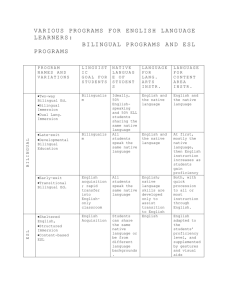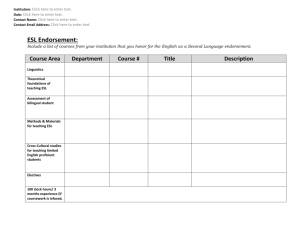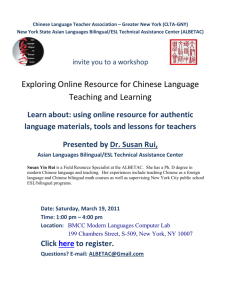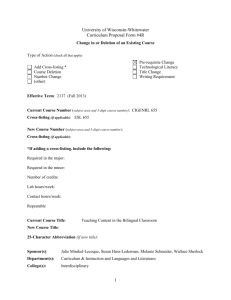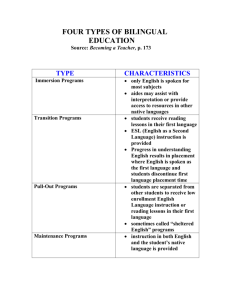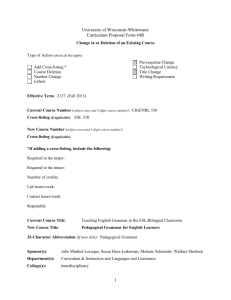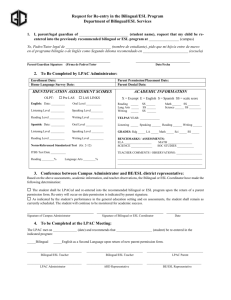MES Language Acquistion Model
advertisement
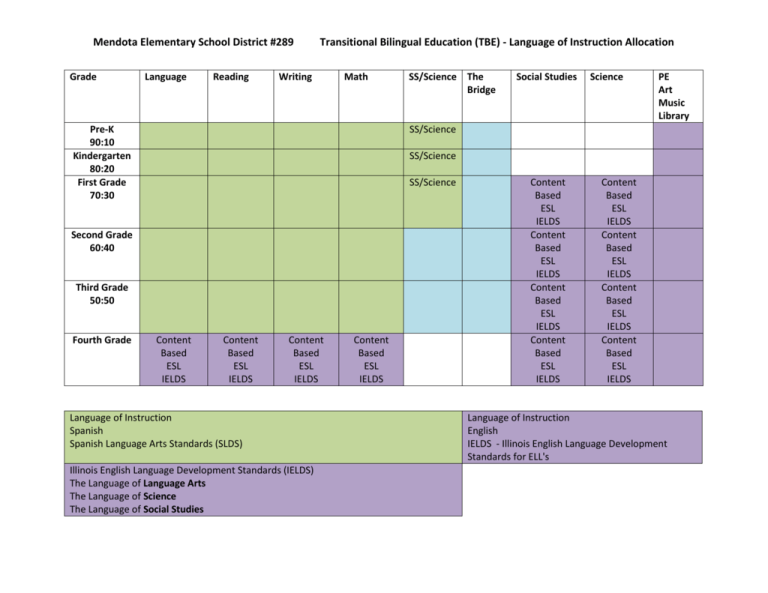
Mendota Elementary School District #289 Grade Language Reading Transitional Bilingual Education (TBE) - Language of Instruction Allocation Writing Math Pre-K 90:10 Kindergarten 80:20 First Grade 70:30 Social Studies Science PE Art Music Library SS/Science SS/Science SS/Science Second Grade 60:40 Third Grade 50:50 Fourth Grade SS/Science The Bridge Content Based ESL IELDS Content Based ESL IELDS Content Based ESL IELDS Language of Instruction Spanish Spanish Language Arts Standards (SLDS) Illinois English Language Development Standards (IELDS) The Language of Language Arts The Language of Science The Language of Social Studies Content Based ESL IELDS Content Based ESL IELDS Content Based ESL IELDS Content Based ESL IELDS Content Based ESL IELDS Content Based ESL IELDS Content Based ESL IELDS Content Based ESL IELDS Content Based ESL IELDS Language of Instruction English IELDS - Illinois English Language Development Standards for ELL's Mendota Elementary School District #289 Transitional Bilingual Education (TBE) - Language of Instruction Allocation Mendota Elementary School District #289 90:10 Early Childhood Education Classroom Environment 90% Spanish 80:20 The Bridge 20% English The Bridge 30% English The Bridge 40% English The Bridge 50% English Second Grade Classroom Environment 60% Spanish 50:50 10% English First Grade Classroom Environment 70% Spanish 60:40 The Bridge Kindergarten Classroom Environment 80% Spanish 70:30 Transitional Bilingual Education (TBE) - Language of Instruction Allocation Third Grade Classroom Environment 50% Spanish Fourth Grade Classroom Environment - Content Based ESL Instruction 100% English Mendota Elementary School District #289 Transitional Bilingual Education (TBE) - Language of Instruction Allocation Spanish Language Allocation The Bridge - EL Puente Reading, Writing, 50-90and Mathematics % of the Language Allocation Aligned with the Spanish Language Development Standards The classroom environment should reflect students generated and/or teacher facilitated work samples that meet the rigor of standards based language and content instruction Interactive Word Walls – students/teacher generated the examples for WW and anchor charts that give special attention to word study skills and different developmental stages reflective of the focus of instruction It is highly recommended that, at the beginning of the school year, teachers and students start the WW with an interactive activity where students place vocabulary related to their learning community with their own picture/drawings under the corresponding letter/chart – this will be followed with a progression of vocabulary words that reflect the academic rigor, relevance, and relationships within the curriculum. Build on and use previous grade level word wall suggestions based on students’ needs. Visuals, pictures, student generated drawings, realia High frequency words that are often misspelled Words that have the same sound but different letters Words that bin with the silent h Word families High frequency words that need accents Letters with the same sounds Syllables reflecting the linguistic features of the Spanish Language Vowels and consonants Content Based - English as a Second Language (ESL) Constrastive Analysis Between Languages Strategically planned at the end of the unit and/or when a concept is attained Each language is represented side by side by different colors “Green in Spanish and Purple in English along with a visual representation of each word. The Bridge activity begins with literacy instruction in one language through an integrated language arts content unit. From the known to the unknown – Students generate key concept words in L1 and Teacher provides the labels in the other language for what has already been learned, i.e students demonstrate their understanding using movements (TPR) until their knowledge of the word in L2 develops and then they begin speaking. Active engagement of students Contrastive analysis is focused on similarities and differences in L1 and L2 Phonology – sound system Morphology – Awareness of word formation, prefixes and suffixes shared between two languages, and cognates Syntax and grammar – Awareness of sentence structure Pragmatics – Awareness of language use The Unit or lesson STRATEGICALLY ends with extension and application activities in the language to which the students bridged 10-50% of Language Allocation Aligned with the English Language Development Standards (ELDS) The classroom environment should reflect student generated and/or teacher facilitated work samples that meet the rigor of standards based language and content instruction. Development of oral language through the use of : Big Books, Charts/Songs, Read Alouds, Picture Cards, Nursery Rhymes Visuals, pictures, student-generated drawings, realia Build on and use previous grade level word wall suggestions based on student's needs Interactive ESL Word Wall Language Experience and Anchor Charts Sentence Frames and ESL Activities Content area academic vocabulary with visual representations Science and Social Studies Mendota Elementary School District #289 Transitional Bilingual Education (TBE) - Language of Instruction Allocation ELL Student Category Full Time (FT) only Part Time (PT) Part-Time Plus (P+) Transitional Program of Instruction (TPI) ACCESS Scores 0-3.1 (FT) 3.2-3.9 (PT) 4.0-5.0 (P+) 0-5.0 Service Options (Least Restrictive Environment) Self- Contained Self-Contained Self- Contained Self- Contained Teacher Criteria Bilingual Sp. Ed. Teacher OR Bilingual Sp. Ed. Teacher OR Sp. Ed. Teacher & Bilingual General Ed Co-Teacher Sp. Ed. Teacher & Push in Native Language Instruction with Bilingual Teacher Resource Bilingual Gen. Ed. Teacher, pullout with Sp. Ed. Teacher (student will receive core reading instruction in the Gen. Ed. Classroom in native language Inclusion/Co-Teaching Language of Instruction Bilingual Gen. Ed. Teacher, Sp. Ed. Teacher pushes in OR Bilingual Gen. Ed. Teacher and Sp. Ed.Co-Teacher Native Language (50-80%) and English using ELL strategies Sp. Ed. Teacher and Bilingual Gen. Ed. Co-Teacher Sp. Ed. Teacher with ESL Endorsement Non-ESL Endorsed Special Ed. Teacher, consultation with ESL Endorsed staff Sp. Ed. Teacher with ESL endorsement or Non-ESL Endorsed Special Ed. Teacher, consultation with ESL endorsed staff Resource Resource Resource Bilingual Gen. Ed. Teacher, pullout with Sp. Ed. Teacher (student will receive core reading instruction in the gen. ed. Classroom in the native language) Gen. Ed. Teacher with ESL Endorsement, pull-out with Sp. Ed Teacher w/ESL Endorsement Bilingual Gen. Ed. Teacher, Sp. Ed. Teacher pushes in OR Bilingual Gen. Ed. Teacher and Sp. Ed. Co-teacher Native Language (25-50%) and English using ELL strategies Inclusion/Co-Teaching Gen. Ed. Teacher with ESL Endorsement, push-in support and consultation from Sp. Ed. Teacher OR Gen. Ed. Teacher w/ESL Endorsement and Sp. Ed. Coteacher Inclusion/Co-Teaching Inclusion/Co-Teaching Gen.Ed. Teacher with ESL endorsement, push-in support and consultation from Sp. Ed. Teacher OR Gen. Ed. Teacher with ESL Endorsement, pull-out with Sp. Ed. Teacher with ESL endorsement Gen. Ed. Teacher w/ESL Endorsement and Sp. Ed. Co-teacher English Using ELL strategies English Using ELL strategies Mendota Elementary School District #289 Transitional Bilingual Education (TBE) - Language of Instruction Allocation Minutes Per Week for Bilingual/ESL In some situations, a bilingual para may be utilized to provide native language clarification, when direct services are provided by a special education teacher in consultation with a bilingual/ESL endorsed teacher. Effective January 1, 2014, a student entering the second semester of first grade through 12th grade, must achieve an overall composite proficiency level of 5.0 as well as a reading proficiency of 4.2 and a writing proficiency of 4.2 on the ACCESS test to be considered English Language proficient. Mendota Elementary School District #289 Transitional Bilingual Education (TBE) - Language of Instruction Allocation Illinois Administrative Code 228.30 Instructional Specifications 4. Bilingual Instruction : "Beginning with the 2012-2013 school year, instruction in Spanish Language Arts shall be aligned to the standards that are appropriate to the ages or grade levels of the student served, which are set forth in the document titled "World Class Instructional Design and Assessment: Spanish Language Arts Standards" (2005) 6. Program Integration: In the courses of subjects in which language is not essential to an understanding of the subject matter, including, but not necessarily limited to art, music, and physical education, English learners shall participate fully with the English speaking classmates. Specific Requirements for Transitional Bilingual Education (TBE) Programs 1. Each full time TBE program shall consist of at least the following components: a. Instruction in subjects which are either required by law or by the student's school district, to be given in the student's home language and in English; core subjects such as math, science, and social studies must be offered in the student's home language, except as otherwise provided in subsection (c) (3) - (Part time placement) b. Instruction in the language arts in the student's home language c. Instruction in English as a Second Language, which must align to the 2012 Amplification of English Language Development Standards K-12 (ELDS) d. Instruction in the history and culture of the country, territory, or geographic area which is the native land of the students or of their parents and in the history and culture of the United States
